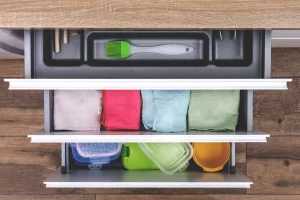 Cleaning and organising go hand in hand. But junk drawers come in handy when you are decluttering and putting items away. To be honest, how many junk drawers do you have in your kitchen? You’re not alone if you can’t answer that question. Many of us believe we are organised enough to answer “one” but the truth may be far from that. This is why you should learn how to organise junk drawers so they are not so..well, junky.
Cleaning and organising go hand in hand. But junk drawers come in handy when you are decluttering and putting items away. To be honest, how many junk drawers do you have in your kitchen? You’re not alone if you can’t answer that question. Many of us believe we are organised enough to answer “one” but the truth may be far from that. This is why you should learn how to organise junk drawers so they are not so..well, junky.
The junk drawer is never intentionally designed to be a junk drawer. It usually begins as something pretty functional, such as the location for our piping bags or the keeper of cheese knives. Then there is life! The cheese knives are suddenly mixed in with the bottle openers, as are batteries, matchbooks, a half-empty container of super glue, and some random cookie cutters.
It doesn’t have to be this way if you know how to organise junk drawers and transform them into a helpful storage location. All junk drawers have a terrible reputation, yet they are often the first place we search when something goes missing. We appreciate their existence when they deliver. When they don’t, they become just another place in our regular housekeeping cleaning list to clean and arrange.
You don’t really need a professional cleaning degree to get your junk drawers under control. All you have to do is follow this guide and have a little creativity
Decluttering kitchen junk drawers
Cleaning out your kitchen junk drawer is similar to cleaning out a closet, only – it is smaller. The idea is to clean up and optimise. Whether you are cleaning and organising rooms, kitchen cabinets, and drawers, the first step is to empty the contents of your cluttered junk drawer onto your kitchen countertop and take inventory.
Declutter and purge
Burned-out light bulbs, excess paper clips, and old paper clips are obviously garbage candidates. But you will need to dig deeper. Do you have duplicate products, tape dispensers that are nearly empty, or broken birthday candles, they are on their way out. Check your inventory and throw away whatever you can. Have no mercy. Sort items together, and keep papers, instruction manuals, outdated menus, and other paper materials in a separate location (like the bin).
Tape some clear plastic sleeves to the inside of a rarely used cabinet for easy access if you want to go a step further and create a DIY place for paper things.
This is a handy place to keep minor appliance instructions, receipts, recipes, and just about anything else made of paper. What about those old takeaway menus? Most restaurants now post their menus online, and many instruction books and manuals can be found on the internet as well.
Dress things up
Shake out all the dust and debris in your empty drawer by turning it over to your garbage bin.
Allow it to dry after wiping the inside and outside with a moist cloth.
Fill the bottom of your junk drawer with shelf paper or drawer liner.
Drawer liners are available in a variety of textures, colours, and designs, so you should have no trouble finding one that matches your style. If you’re feeling very inventive, you could even paint the insides of your drawers to brighten them up and add some colour to your kitchen.
Bring the fun back
Now that you’ve decluttered and cleaned, it’s time to reorganise your junk drawer. But you don’t need to buy expensive drawer organisers to get the job done.
Here are a few DIY junk drawer organisation ideas to help you make the most of your storage:
To make a junk drawer organiser, use a cardboard bottle divider from liquor, beer, or wine case. They’re simple to cut to size and may be used to make a number of discrete storage chambers that fit almost any drawer.
Using ice cube pans, make tiny sections in your junk drawer.
Repurpose a cutlery or utensil tray to arrange similar objects into divisions. These removable trays are perfect for kitchen junk drawers since they make the contents visible.
Make the Habit Last
Make a pledge to yourself that you will not let your first disorderly junk drawer get out of hand again. Keep in mind that everything should have a home. Now onto the remaining junk drawers!
In general, know what you need best, keep it accessible, and do not let any other not-so-important intruders get into your drawer. Add this to your regular cleaning schedule and do not forget to make an inventory once in a while, just to keep track of what has ended up in there.
By decluttering your junk drawer once every two months, you will be able to turn it into a useful drawer that will no longer clutter your house or life.